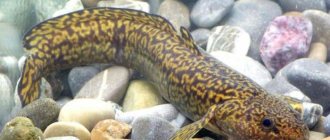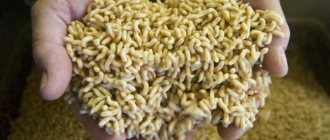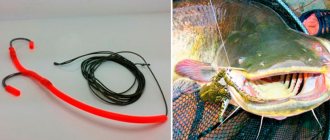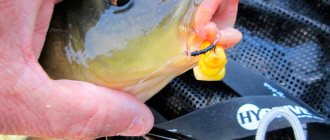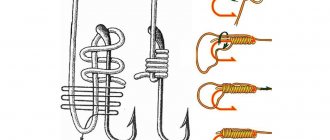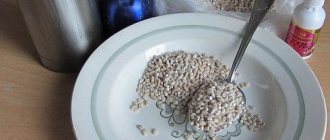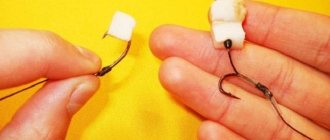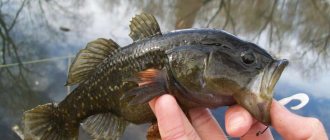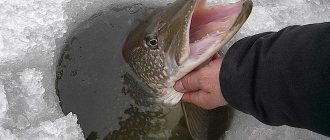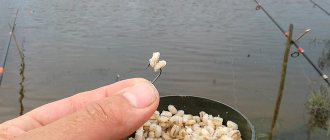Chicken liver as fishing bait
Such bait for chub and catfish will also be a desirable delicacy, the main thing is that the chicken liver is raw.
Tip: eating chicken liver in another form (boiled or scalded with boiling water) will reduce the effectiveness of biting, since the treated bait loses the smell of blood and the reddish color that attracts fish so much.
2.1 Methods for attaching chicken livers to a hook
- You can find detailed instructions on how to most effectively attach chicken livers to a hook and a double on one of our pages.
- The fresh liver is placed in a nylon stocking, pierced at the top and rotated around the hook and pierced with the tip of the hook. You can pre-tie the bait with thread.
- You can mix the bait with flour and pass the mixture through a blender (meat grinder), roll into balls and place on a hook. The flour will glue the mass together and prevent it from falling apart.
Read a detailed article about a fishing hook, its structure, features, types, methods of use and storage here
How to choose the right fishing hook, what key points you should not miss when purchasing, read this detailed article
2.2 Fishing technique when using chicken liver
When using chicken liver, the bait is cast downstream (35 degrees to the water flow). The hook must be sharp, as the fish can easily rip it off the hook, since the liver is not firmly held on the hook.
Catching chub in winter using chicken liver
For such fishing you need to find a narrow, flat place on the river. Having arrived at the site of the creek, the equipment is prepared. Fresh chicken liver is used for bait. Such a liver is very delicate and will only need to be pierced in one place. The liver holds very well on medium-thick wire hooks with a short shank. The reinforced equipment is immersed exclusively in the reverse flow zone.
In the middle of the creek there are always large individuals of chub that adore fresh, animal bait.
You should wait for a bite for a few minutes. If you ignore the fish, you need to throw several small pieces of liver directly into the water. This way the fish's appetite will be awakened.
How to catch catfish using chicken liver
6 minutes Author: Valentin Porokhnya 0
Catfish is the largest fish found in freshwater reservoirs in the middle zone: many fishermen who specialize in catching it do not consider catfish weighing less than 10 kilograms a worthy catch. There are a lot of ways to catch river giants, but the most popular option is a variety of bottom gear. Each region has its own favorite bait options. In some places they prefer crawling fish, in others they prefer leeches and frogs; livers of various animals are also a popular bait.
Suitable tackle
Given the size and strength of this fish, the rod must be appropriate. Not all forms are able to withstand the jerks of a 10-kilogram catfish or more. Mainly feeder and spinning rods are used.
Feeders are usually used in the extra-heavy class, with a dough weight of more than 150 grams. The length of the form is selected according to the characteristics of the fishing location. For small rivers, in places where there is no need for long casts, a 3-meter fishing rod is quite enough. Where holes and debris of snags are located at a considerable distance from the coastline, longer models are more appropriate - 3.9 or 4.2 meters. In the case of catching trophy catfish, a medium or slow action is preferable, since such rods are able to dampen the jerks of large fish due to the work of the blank itself.
Spinning rods are also often used as donks. Despite the short length of most of these rods, they are quite convenient when fishing and are well suited for catching catfish in places where the casting distance of the bait is not critical. The test of such a spinning rod must be at least 80 grams, and the form itself must have a significant margin of safety. The build, just as in the case of the feeder, is preferable to medium or slow. Fast forms, despite accurate casting and other advantages, practically do not dampen the jerks of the fish, which in the case of trophy catfish threatens to break the tackle.
Coils need to be appropriate. For a feeder - no less than 6000 standard size, and it is desirable that the inertia-free feeder be power-driven, with a low gear ratio. With spinning reels the situation is approximately the same: a standard size of at least 4000–5000, a power version and a fairly durable body in the case of catfishing are a necessity. Multiplier reels work well. They have a sufficient margin of safety and also work well with large diameter fishing line.
In places where catfish pits, as well as hunting grounds where the fish go out at night to get food, are located near the shore, many fishermen limit themselves to extremely primitive gear - a zakidushka. The hook itself is a piece of fishing line or cord with a hook and sinker. You won’t be able to fight trophy fish using such gear, but it’s quite suitable for relatively small catfish.
How to catch chub with liver
When fishing for chub, a rod up to 3 meters long is used. A section of the river with a fast current and whirlpools is selected. The rig is thrown downstream. We fish with one fishing rod, as we often have to change our fishing spot. Fishing for the liver of a chub does not require the fisherman to stay in one place. This is mobile fishing. It is better to hold the fishing rod in your hands, as its bites are very greedy and often the rod can end up in the water without supervision. What equipment is suitable for chub fishing? Most often, a fishing line with a thickness of 0.3 mm is used, on which a sliding weight runs. A leash with a diameter of 0.25 with a hook on a long fore-end No. 6-8 is attached to the end. If it is a tee, then No. 8, and if it is a single, then No. 6.
The weight of the sinker is selected based on the strength of the current. Typically it varies from 40 to 80 grams. It is necessary that it moves slightly downstream. The length of the leash, as we see, is quite large, approximately 60-70 cm. This is the optimum that will allow you to feed the bait as naturally as possible and make it moveable under the influence of the current. Moving bait provokes the chub to bite.
Usually chub fishing looks like this. The equipment is thrown to a promising point. This could be an area with a rip current, where the water churns or the current changes direction slightly. We cast it and wait 5-10 minutes for a bite. If it is not there, we throw it at another point: under a snag or on a hole, and again wait a little. We fish a place for 30-40 minutes and move to another if there are no bites.
If a large chub bites, then after fishing there is a pause of 15-20 minutes. Under no circumstances should you change your location. Chubs prefer to sit in the same places. You just have to wait out this time and you can again count on biting and catching fish.
Features of the nozzle
Catching catfish with chicken liver may well bring good results, because this fish, in its feeding habits, is closer to scavengers, and does not hesitate to pick up dead animals whose bodies have fallen into the water in one way or another. The liver, although it does not attract fish with active movements, as happens with crawlers, frogs or leeches, the main attracting factor here is the smell. At the same time, many fishermen note that catfish can gather for this scent from a fairly large distance. There are also those who believe that if the liver begins to deteriorate, then this is not only not terrible, but even good - the rotten smell of the lungs in some reservoirs attracts catfish even better than fresh liver.
The ability of the liver odor to attract catfish is especially pronounced in bodies of water with at least a slight current. Under such conditions, the aroma spreads quite far.
Baits for burbot fishing
The most common baits that give good results for catching this fish are:
- live bait;
- dead fish;
- pieces of fish;
- frog;
- bunch of worms;
- crawl out;
- chicken liver;
- cancer;
- shrimps;
- leeches;
- insect larvae.
Burbot can be caught on a spinning rod, but this is more of an accident. As a rule, burbot can bite as a result of the process of catching a predator such as pike perch or perch. Here everything depends on the behavior of the burbot, but it is not an object of spinning fishing, despite the fact that it is a predator.
Burbot can be successfully caught with any bait included in this list. Moreover, this does not mean that all of them are suitable for fishing in any body of water. In each reservoir, burbot feeds differently, depending on the nature of the reservoir, as well as the presence of predominant food items. One body of water may be dominated by crayfish, while another may be dominated by fish. It’s not difficult to imagine what burbot likes in this case.
Autumn bait
The most recommended bait for autumn burbot fishing is a bunch of dung worms or crawlers. Worms are included in the diet of burbot and other fish. But it may happen that another fish is caught on the hook, and then a burbot approaches the tackle. In this case, the fish caught on the hook will serve as live bait.
Winter bait
In winter, burbot shows maximum activity, while other fish species either hibernate or reduce their activity. The best and most effective bait during this period will be live bait. For burbot, the colder the water, the better.
Spring bait
In the spring, the best bait is a frog. But this does not mean at all that this rule applies to all bodies of water. In any given body of water, the most attractive baits may or may not work.
Summer bait
In the summer, burbot shows minimal activity, and sometimes even goes into hibernation. It all depends on weather conditions and water heating. In other words, the climatic conditions of the region are decisive in terms of burbot activity. If burbot is caught in the summer, then bait such as a crawler or a bunch of worms is suitable for it.
Catfish baits
The most, because this fish is active at night. In spring, catfish most often spend time in places that are well warmed up by the sun's rays.
In these places it is caught well on all animal baits. Catfish love baits that smell like feathers, felt or burnt wool.
The choice of food for this giant is primarily based on smell, so the use of odorous baits can play an important role in increasing fishing efficiency.
Catfish loves chicken meat fried over an open fire, and especially loves fresh chicken liver, which it can bite on even during the daytime. Since catfish is a bottom-dwelling fish, experienced fishermen usually catch it on the liver from the bottom.
When does a chub bite on the liver?
Raw chicken liver can be successfully used in spring and autumn chub fishing. But in the hot summer time, the diet of chubs contains many other food options: from flying insects to fry and frogs - so fishing with the liver is less effective at this time. Only when the water is cool does the chub take excellent bait on chicken liver.
However, the chub bites quite well on the liver during the summer cold snap, when the air temperature drops to 14-17 degrees.
Sources:
https://isradag.ru/nazhivki-dlya-rybalki/kurinoe-myaso-kak-nazhivka-dlya-presnovodnoj-rybalki.html https://intellifishing.ru/nasadki/kak-lovit-soma-kurinuyu-pechen https: //rybalkarybaka.ru/pechen-nasadka-rybalke/
